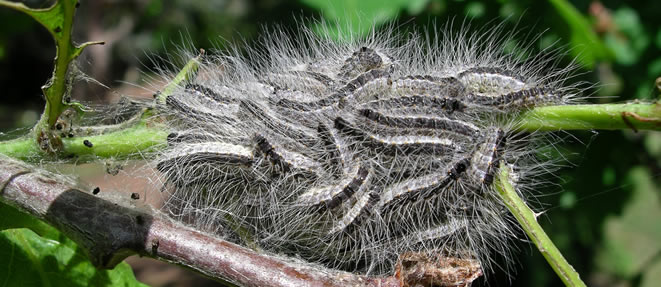
Why Complete Tree Care?
Complete Tree Care has considerable experience in Oak Processionary Moth Control (OPM). We are based in the OPM control area and are included on the Forestry Commission Inspectors’ list of contractors for OPM control. Due to our location we can provide an immediate response with staff who are trained and experienced; giving you the peace of mind that the outbreak will be eradicated to the FC Inspector’s satisfaction. Please contact us for further details and information on the Oak Processionary Moth Control services we provide.
The Oak Processionary Moth is native to southern and central Europe and was discovered in Oak trees in the UK in 2006. The larvae (caterpillars) feed on the foliage of many species of oaks, including English, Sessile and Turkey oaks (Quercus robur, Q.petraea and Q.cerris) and can cause severe defoliation. This in turn may lead to the trees infection with other diseases resulting in the tree’s death.
Oak Processionary Moth is also a risk to human health. The larvae (caterpillars) are covered in irritating hairs that contain a toxin and contact with these hairs, or their inhalation, can result in skin irritation and allergic reactions. These problems are significant because the Oak Processionary Moth is often most abundant on urban trees.
OPM was first discovered in the UK in Richmond in 2006. A high incidence of rash amongst residents on housing estates led to an investigation by Environmental Health services. A second site was identified on Hanger Lane near the A40, where imported oak trees had been planted at around the same time. By 2010 OPM had spread to a total of five London boroughs; Hounslow, Ealing, Richmond, Wandsworth and Brent, plus the town of Pangbourne in Berkshire.
Current Oak Processionary Moth Control Control Measures:
Due to the failure to eradicate OPM in the core area the Forestry Commission changed tack in 2011 and decided on a policy of containment. This involved the creation of a buffer zone around the five London Boroughs. Oak trees within the buffer zone would be inspected and owners of trees with OPM served notice to have the pest treated within a specified time period. This is usually the destruction of the nests prior to them hatching into moths which will then spread to other trees.
Complete Tree Care undertakes this work using our highly trained staff. Wearing full protective clothing to avoid contamination by the hairs the nests are removed by hand and double bagged. The nest area is burned using a blow torch to eradicate hairs and larvae. They are then taken to a licensed site for incineration. Once the Oak Processionary Moth control work has been completed the inspector returns to all trees identified to check the work has been done satisfactorily.
Note: Banner image courtesy of the Forestry Commission